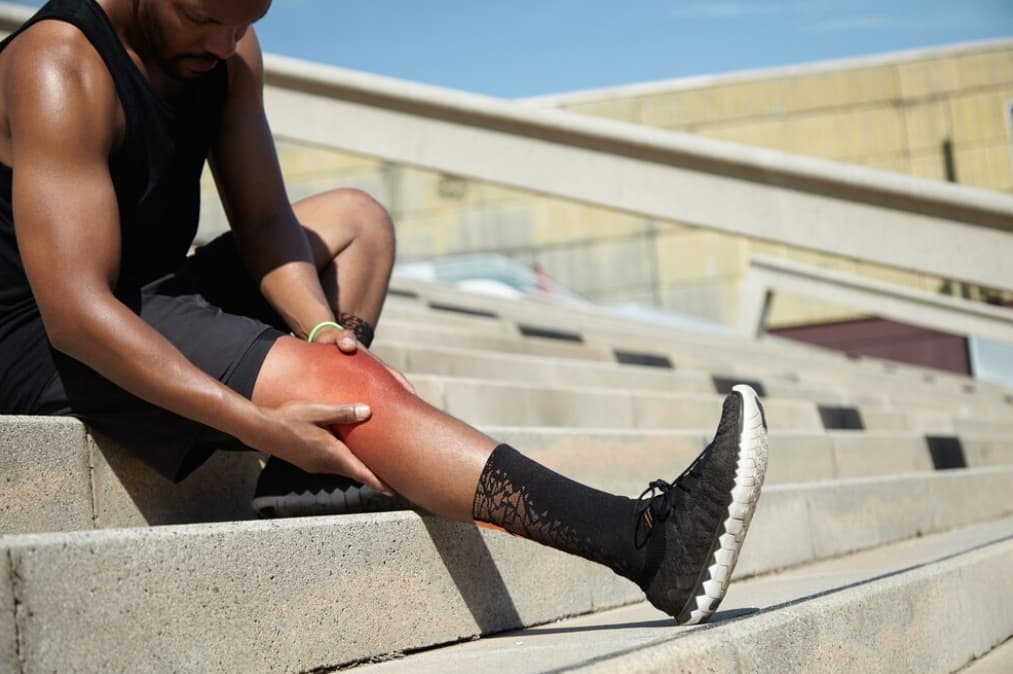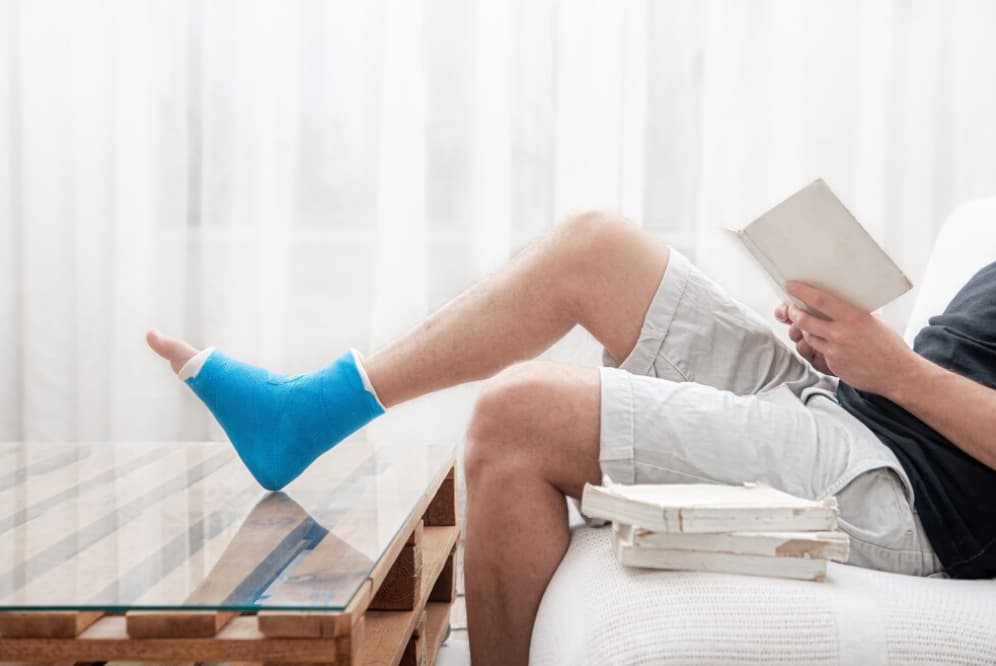The Top 7 injuries frequently observed in the parkour community, which also happen to be the most commonly experienced ones, will be listed and explained. Understanding the reasons behind these injuries and their prevalence can assist in preventing them, thereby saving individuals from pain and lost time.
While discussing the top 7 frequently occurring injuries in parkour, you may also like to explore the article on ‘How to Parkour Roll,‘ which can provide valuable insights on proper technique.
Bruises on Feet and Hands
Bruises on the feet and hands in parkour typically result from impact force injuries. These injuries usually occur due to excessive impact, incorrect technique, or inadequate conditioning for absorbing such impact. High-impact maneuvers like major landings, extended or elevated precision jumps, diving kongs, dive rolls, and similar activities are common culprits. Since parkour extensively involves the use of both hands and feet, these injuries can be quite persistent and slow to heal.
Fortunately, these bruises are generally minor, causing more discomfort than actual disability. However, if significant swelling is observed or if the pain does not subside after a few days, it might indicate a more serious issue, such as a hairline fracture. In such cases, medical consultation is advised to determine if extended rest is necessary.
To prevent these types of injuries, the following steps can be helpful:
- Mastering correct techniques for landing and vaulting;
- Ensuring force distribution is balanced across the body. For instance, in a basic landing, keep legs shoulder-width apart, land on the balls of the feet, and align joints correctly;
- Progressing gradually, starting with less demanding activities to allow the hands and feet to strengthen over time;
- Exploring barefoot training and conditioning to enhance foot strength and resilience.
Shin Injuries in Parkour

Shin injuries can be extremely painful and problematic, particularly in activities like parkour. The shin, being a sharp and sensitive bone with minimal natural protection, is prone to cuts and deep gashes. These injuries are often a result of failed precision jumps or slips during rail work. A common mistake that leads to these injuries is positioning one foot slightly ahead of the other during precision jumps. This misalignment can cause the trailing foot to slip off the rail or ledge, resulting in the shin striking the obstacle with full force.
To minimize the risk of shin injuries, consider the following preventative measures:
- Ensure that both feet are close together and aligned when executing precision jumps;
- Progress incrementally, starting with smaller landings and gradually increasing to larger gaps. This approach allows the body to develop better coordination and spatial awareness.
Knee Injuries
Knee injuries, often referred to as ‘knee capitations’ in dynamic sports and activities, can be particularly distressing. These injuries typically occur when the knee, or sometimes the upper thigh, collides with an obstacle during high-velocity movements. Common scenarios include performing kong vaults, speed vaults, or rapid climb-ups, where a slightly misjudged knee height can lead to a painful collision with a ledge or rail. The impact can be severe enough to cause significant discomfort and, in some cases, even nausea.
To reduce the risk of such knee injuries, adhering to the following preventative measures is advisable:
- Mastering the correct form for various vaults;
- Ensuring that the legs are properly tucked during movements;
- Keeping the hips elevated to avoid low-hanging knees that could lead to impacts.
Knee Sprains and Ligament Injuries
Knee sprains and related ligament injuries, like a torn ACL, are among the most debilitating issues faced in high-impact sports and activities. These injuries often result from improper landing techniques, overtraining, inadequate conditioning, or physical imbalances. The risk significantly escalates when activities involve flips, twists, or jumps from heights.
To minimize the likelihood of knee sprains and enhance overall knee health, the following strategies are recommended:
- Learn and practice proper landing techniques, ensuring the body evenly absorbs impact and maintains joint alignment;
- Allow adequate rest between intensive training sessions, giving the body time to recover and rebuild;
- Implement a comprehensive warm-up routine before each training session to prepare the body for physical stress;
- Condition the body thoroughly, focusing on strengthening both muscles and joints without creating imbalances. Train symmetrically, ensuring equal attention to all limbs and muscle groups. Barefoot training can be beneficial for body alignment and posture, particularly in rectifying foot alignment issues that might impact the knees;
- Develop a consistent stretching routine post-training. Increased flexibility can enhance the body’s capacity to safely handle force;
- Work on improving balance, which in turn can strengthen joints and heighten body awareness, thus reducing the risk of injury.
Ankle Sprains

Ankle sprains are a prevalent injury, especially among those new to dynamic physical activities such as parkour. Commonly occurring during precision jumps, stride precisions, wall runs, or landings, these injuries happen when excessive pressure or strain is placed on the ankle joint. Sprains can result from “jamming,” “twisting,” or “rolling” the ankle, and the likelihood increases with movements that involve additional twisting and flipping. The primary causes of ankle sprains include bodily imbalances, inadequate flexibility, lack of ankle strength, and poor form.
To reduce the risk of ankle sprains, the following preventative measures are recommended:
- Master proper landing techniques, ensuring that the body evenly distributes impact and maintains joint alignment;
- Allow sufficient rest between intense training sessions for body recovery;
- Conduct a thorough warm-up before each training session;
- Engage in proper body conditioning, focusing on strengthening muscles and joints while avoiding creating imbalances. Exercises such as calf raises, squat jumps, and split-leg box jumps are beneficial for building ankle strength. Barefoot training can also aid in body alignment and posture;
- Implement a comprehensive stretching routine post-training, as greater flexibility can enable the body to handle force more safely;
- Work on improving balance, which can enhance joint strength and body awareness;
- Keep the ankle engaged and prepared for landings. For example, pointing the foot during a precision jump allows the ankle joint more room to absorb the impact effectively;
- Give attention to other areas like the hips or shoulders, particularly when learning new moves like the parkour roll, to prevent related injuries.
Shoulder and Hip Bruises
Bruises on the shoulder and hip are common injuries when transitioning from softer surfaces like grass to harder ones, such as concrete, in various physical activities that involve rolling movements. These bruises often occur from impacting too hard on the shoulder or hitting the protruding hip bone. If not addressed through form correction or adequate rest, these injuries can become chronic.
Effective strategies to prevent shoulder and hip bruises include:
- Mastering the correct technique for rolls. If the hip bone is impacted, ensure the legs are tightly tucked throughout the roll. Adjust the exit of the roll to either side or more towards the center of the hip to avoid the bone. This requires some experimentation to perfect. For shoulder impacts, focus on tucking the shoulder more and utilizing the arms for support. Aim to roll over the back of the shoulder, using the muscle to cushion the impact;
- Allowing the body time to rest and recover after sustaining a bruise while working on strengthening the affected areas;
- Starting with very soft surfaces for practice and gradually progressing to harder ones, giving the body time to adapt and build resilience.
Hand Rips
Hand rips are a common injury in physical training activities, especially those involving extensive bar work like laches. Large rips can temporarily disable hand function for bar exercises and are often quite painful. These injuries typically occur due to skin friction against the bar, leading to bunching and eventual tearing of the skin. The risk of severe rips increases with the presence of large calluses or accumulated dead skin, as this extra layer tends to bunch up more easily, resulting in deeper tears. While rips can be painful, they generally heal relatively quickly and usually need only basic care, like cleaning and bandaging, similar to other minor cuts or scrapes.
To prevent hand rips, consider these strategies:
- Regularly remove dead skin and file down large calluses on the hands. This can be done using sandpaper or a pumice stone, which helps to smooth out the skin and reduce the likelihood of it bunching up and tearing during bar exercises;
- Pay attention to early warning signs, such as the feeling of calluses bunching up or pain during bar work. These can be indicators that the skin is close to ripping. In such cases, it’s advisable to stop the bar activity and switch to a different type of exercise.
Conclusion
While parkour is a thrilling and physically demanding discipline, it is crucial to be aware of the potential risks and injuries one can encounter. Proper training, technique, and equipment are vital to ensure safety during practice. An understanding and adherence to these guidelines will significantly reduce injury occurrence in parkour, making the sport more enjoyable and injury-free.